





Many of us are seeing bags and boxes of spring-blooming bulbs in the stores right now, since autumn is a great time to plant them. While you're tucking those tulips, daffodils and narcissus in to your perennial beds, why not force some for a bit of winter cheer?
The windfall of a free refrigerator started me thinking; why not force some spring bulbs to brighten up the gray days to come. It was a perfect excuse to indulge in several packages of inexpensive bulbs that had been beckoning me in their colorful kiosks each time I shopped in my local big box store, so I selected a basket full of likely candidates and triumphantly carried them home.
Forcing spring bulbs to bloom out of season was first popularized in Victorian times. It was quite fashionable to have narcissus, hyacinths and tulips on display in well-appointed parlors of the time and a whole industry of special cachepots and bulb-forcing vases was born out of popular demand.
The whole idea of this custom was to fool the bulbs into thinking they had experienced winter conditions and that it was time to begin their spring show. The practice continues today and shoppers are often tempted with colorful pots of spring bulbs for sale in the dead of winter. Gardeners (and non-gardeners) can eliminate the middleman and do this themselves with just a little instruction and a spot for the bulbs to ‘cool their heels' for a few weeks.
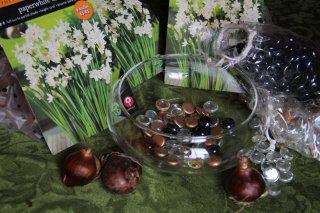 Paperwhites, or Narcissus tazetta are the easiest bulbs to force. They do not need a period of cold weather to bloom, so there isn't any need to make room in the refrigerator to give them a chill. Many people simply use a bowl or dish and some decorative pebbles to put on a fantastic show. I had a flat, shallow bowl that was perfect and a quick run to the craft aisle resulted in some decorative glass pebbles. Place a layer of pebbles in your container and then ‘plant' the narcissus bulbs. Place them close together with the pointed ends sticking up and then add some more pebbles to give the bulbs stability. Fill with water to the bottom of the bulbs. The water needs to be close, but not covering the bulbs. If they sit in water any deeper than the base of the bulb, they will rot.
Paperwhites, or Narcissus tazetta are the easiest bulbs to force. They do not need a period of cold weather to bloom, so there isn't any need to make room in the refrigerator to give them a chill. Many people simply use a bowl or dish and some decorative pebbles to put on a fantastic show. I had a flat, shallow bowl that was perfect and a quick run to the craft aisle resulted in some decorative glass pebbles. Place a layer of pebbles in your container and then ‘plant' the narcissus bulbs. Place them close together with the pointed ends sticking up and then add some more pebbles to give the bulbs stability. Fill with water to the bottom of the bulbs. The water needs to be close, but not covering the bulbs. If they sit in water any deeper than the base of the bulb, they will rot. 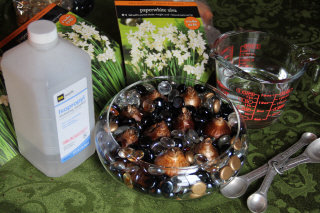 I added a teaspoon of alcohol to the water. This prevents mold and keeps the foliage shorter. Even vodka or food-grade alcohol will work, but rubbing alcohol is fine as well. When the roots start to grow and foliage starts to emerge, place in a sunny area and give the bowl a quarter turn each day to ensure that the foliage grows straight. Add the alcohol-water as needed and soon your bulbs will begin to sprout flower stalks.
I added a teaspoon of alcohol to the water. This prevents mold and keeps the foliage shorter. Even vodka or food-grade alcohol will work, but rubbing alcohol is fine as well. When the roots start to grow and foliage starts to emerge, place in a sunny area and give the bowl a quarter turn each day to ensure that the foliage grows straight. Add the alcohol-water as needed and soon your bulbs will begin to sprout flower stalks.
Your area shouldn't be very warm, remember, these are flowers of early spring and do best with temps on the cool side. Blooms should start to emerge in about 3 weeks. By staggering your planting times, you can have fresh, living flowers all winter.
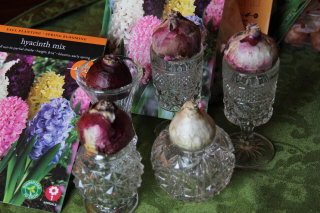 Hyacinths have been popular forcing bulbs since Victorian times. In fact, a whole industry to produce special hyacinth vases was born and the antique vases are very collectable. Many can still be found in antique shops and on-line auctions today and they can command some outstanding prices. These bulbs need a bit of special treatment, but the show is well worth it. I didn't have any specialized hyacinth vases, but a quick search of my glass cabinet produced some tiny vases and goblets that served the same purpose, and they were free. Fill your containers with water to just below, but not touching the bulb and place in a cool, dark place for 8 to 16 weeks. Optimal temperatures are from 40F to 48F, so most modern refrigerators are too cool. I had the luxury of being able to set the thermostat on my free refrigerator to a bit warmer than normal since I wasn't keeping perishable food in it. You can place your bulbs in any unheated room or shed, just make sure that they do not freeze. When the roots fill the container and it starts to sprout shoots, move it to a cool room with filtered light. Add water as needed during this time and change the water if it becomes cloudy or moldy. After about a week, you can move your hyacinths to a bright room, and remember to turn your container to keep your plants growing upright. Some varieties force successfully by simply storing the bulbs in a paper bag in the refrigerator for 8 to 10 weeks and then placing them in the vases with indirect light, but as the old saying goes; "Your mileage may vary." Display your blooming hyacinths in a cool room, because like the narcissus, they are flowers of spring and do best when the temperature mimics that season.
Hyacinths have been popular forcing bulbs since Victorian times. In fact, a whole industry to produce special hyacinth vases was born and the antique vases are very collectable. Many can still be found in antique shops and on-line auctions today and they can command some outstanding prices. These bulbs need a bit of special treatment, but the show is well worth it. I didn't have any specialized hyacinth vases, but a quick search of my glass cabinet produced some tiny vases and goblets that served the same purpose, and they were free. Fill your containers with water to just below, but not touching the bulb and place in a cool, dark place for 8 to 16 weeks. Optimal temperatures are from 40F to 48F, so most modern refrigerators are too cool. I had the luxury of being able to set the thermostat on my free refrigerator to a bit warmer than normal since I wasn't keeping perishable food in it. You can place your bulbs in any unheated room or shed, just make sure that they do not freeze. When the roots fill the container and it starts to sprout shoots, move it to a cool room with filtered light. Add water as needed during this time and change the water if it becomes cloudy or moldy. After about a week, you can move your hyacinths to a bright room, and remember to turn your container to keep your plants growing upright. Some varieties force successfully by simply storing the bulbs in a paper bag in the refrigerator for 8 to 10 weeks and then placing them in the vases with indirect light, but as the old saying goes; "Your mileage may vary." Display your blooming hyacinths in a cool room, because like the narcissus, they are flowers of spring and do best when the temperature mimics that season.
Tulips are a welcome sign of spring, but sometimes it's hard to wait that long. Forcing tulips isn't a hard process and even gardeners in warm winter areas can enjoy some delightful blooms by following these steps.
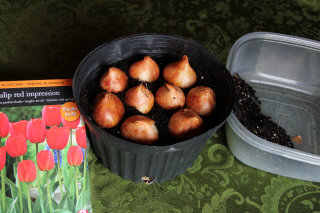 I chose a nursery pot that was wider than it was tall. You don't need a deep container for forcing tulips and I was going to slip the nursery pot in a decorative container when it bloomed, so it was a great choice. Just make sure that the eventual top-heavy tulips do not make your container unstable. Add a layer of potting mix and then place your tulip bulbs on top of it. You want the tops of the bulbs to be level with the top of the container, so add or remove potting mix until this level is reached. Tulip bulbs are not completely spherical. They have a flat side and a rounded side and the way they are placed in the container will make for a more attractive show. The flatter side of the tulip bulb should be to the outside of the pot. This side of the bulb produces the biggest leaf and if all of the flat sides are facing out, the foliage will be the most attractive. Add potting mix until just the tips of the bulbs are peeking out and cover with a plastic bag that has a few holes poked in it. This will prevent the soil from drying out quickly. (Just remember to check it occasionally and water as needed) Place in your refrigerator or in a cool, dark room for 8 to 16 weeks. Roots will start to emerge from the drain holes when they are ready. Bring into a cool room and once they start to produce shoots, move to a sunny area.
I chose a nursery pot that was wider than it was tall. You don't need a deep container for forcing tulips and I was going to slip the nursery pot in a decorative container when it bloomed, so it was a great choice. Just make sure that the eventual top-heavy tulips do not make your container unstable. Add a layer of potting mix and then place your tulip bulbs on top of it. You want the tops of the bulbs to be level with the top of the container, so add or remove potting mix until this level is reached. Tulip bulbs are not completely spherical. They have a flat side and a rounded side and the way they are placed in the container will make for a more attractive show. The flatter side of the tulip bulb should be to the outside of the pot. This side of the bulb produces the biggest leaf and if all of the flat sides are facing out, the foliage will be the most attractive. Add potting mix until just the tips of the bulbs are peeking out and cover with a plastic bag that has a few holes poked in it. This will prevent the soil from drying out quickly. (Just remember to check it occasionally and water as needed) Place in your refrigerator or in a cool, dark room for 8 to 16 weeks. Roots will start to emerge from the drain holes when they are ready. Bring into a cool room and once they start to produce shoots, move to a sunny area.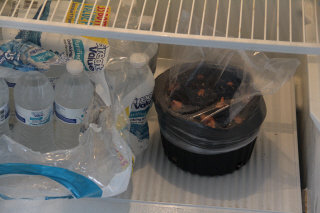
By timing your plantings, it is possible to have something blooming all winter. Now is the time to purchase your bulbs and prepare them for their winter show. Just remember that they cannot freeze and if you are using a refrigerator, do not store fruit in it while you are conditioning the bulbs. Ethylene gas produced by the fruit affects the flower inside the bulb and the results may be less than desirable. After the bulbs have bloomed, you can discard them or snip the flowering stalk and plant them in the garden. They may eventually recover, but it could take several seasons.
Forced bulbs make excellent winter decorations and holiday gifts, so be sure to plant plenty!
Thumbnail image courtesy of Wikimedia Commons, all the rest of the images are my own.
Copyright © www.100flowers.win Botanic Garden All Rights Reserved